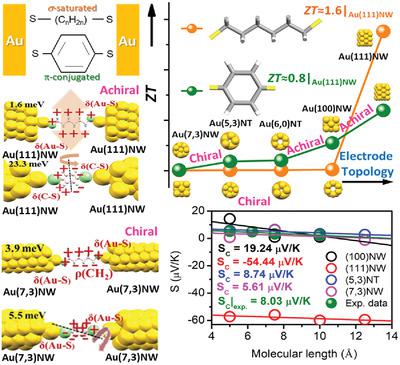当前位置:
X-MOL 学术
›
Adv. Theory Simul.
›
论文详情
Our official English website, www.x-mol.net, welcomes your feedback! (Note: you will need to create a separate account there.)
Inelastic Tunnel Transport and Nanoscale Junction Thermoelectricity with Varying Electrode Topology
Advanced Theory and Simulations ( IF 3.3 ) Pub Date : 2021-04-25 , DOI: 10.1002/adts.202100054 Talem Rebeda Roy 1 , John Donald Raj J 1 , Arijit Sen 1
Advanced Theory and Simulations ( IF 3.3 ) Pub Date : 2021-04-25 , DOI: 10.1002/adts.202100054 Talem Rebeda Roy 1 , John Donald Raj J 1 , Arijit Sen 1
Affiliation

|
Intricacies in the charge transport behavior of single-molecule junctions often revolve around the complex nature of orbital hybridization stemming from diversified metal-molecule coupling at interfaces. It will hence be pertinent to fathom the myriad aspect of inelastic charge transport and nanoscale thermoelectricity in single-molecule junctions. It is examined from first-principles, achiral and chiral quasi-1D electrodes to understand the role of junction heterogeneity in overall thermoelectric behavior during charge transport. This calculated inelastic electron tunneling spectra exhibit intense peaks in the low-frequency regime (< 25 meV) with characteristic bending and rocking modes, which auger well with the available measured data. It is subsequently found that the thermopower can be as high as 212 µV K−1 for σ-saturated molecular moieties, depending strongly on the configuration of electrodes. Besides, a majority of such single-molecule junctions turn out to deviate from the Wiedemann–Franz law, leading to anomalies in the electronic thermal conductance. The authors' analysis suggests that as nanoscale electrodes, Au(111) nanowires are likely to render a relatively high thermoelectric figure of merit (ZT > 1) for a small molecular junction at room temperature. Discerning the diversity as driven exigently by the electrode topology may thus augment the device performance in terms of thermal stability at molecular scale.
中文翻译:

具有不同电极拓扑结构的非弹性隧道传输和纳米级结热电
单分子结的电荷传输行为的复杂性通常围绕着源于界面处多样化金属-分子耦合的轨道杂交的复杂性质。因此,了解单分子结中非弹性电荷传输和纳米级热电的无数方面将是相关的。从第一性原理、非手性和手性准一维电极对其进行检查,以了解结异质性在电荷传输过程中的整体热电行为中的作用。这种计算出的非弹性电子隧穿光谱在具有特征弯曲和摇摆模式的低频区域 (< 25 meV) 中表现出强烈的峰值,这与可用的测量数据相吻合。随后发现热电势可高达 212 µV K -1对于 σ 饱和的分子部分,很大程度上取决于电极的配置。此外,大多数这样的单分子结都偏离了 Wiedemann-Franz 定律,导致电子热导异常。作者的分析表明,作为纳米级电极,Au(111) 纳米线可能会在室温下为小分子结提供相对较高的热电品质因数 ( ZT > 1)。因此,区分电极拓扑结构迫切驱动的多样性可以增强器件在分子尺度上的热稳定性方面的性能。
更新日期:2021-06-05
中文翻译:

具有不同电极拓扑结构的非弹性隧道传输和纳米级结热电
单分子结的电荷传输行为的复杂性通常围绕着源于界面处多样化金属-分子耦合的轨道杂交的复杂性质。因此,了解单分子结中非弹性电荷传输和纳米级热电的无数方面将是相关的。从第一性原理、非手性和手性准一维电极对其进行检查,以了解结异质性在电荷传输过程中的整体热电行为中的作用。这种计算出的非弹性电子隧穿光谱在具有特征弯曲和摇摆模式的低频区域 (< 25 meV) 中表现出强烈的峰值,这与可用的测量数据相吻合。随后发现热电势可高达 212 µV K -1对于 σ 饱和的分子部分,很大程度上取决于电极的配置。此外,大多数这样的单分子结都偏离了 Wiedemann-Franz 定律,导致电子热导异常。作者的分析表明,作为纳米级电极,Au(111) 纳米线可能会在室温下为小分子结提供相对较高的热电品质因数 ( ZT > 1)。因此,区分电极拓扑结构迫切驱动的多样性可以增强器件在分子尺度上的热稳定性方面的性能。



























 京公网安备 11010802027423号
京公网安备 11010802027423号